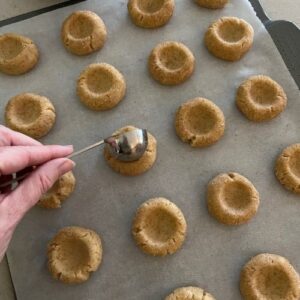
Sourdough Snickerdoodle Cookies Recipe
A sourdough version of your favorite snickerdoodle cookie. These are a little tangy, crispy on the edges and soft in the middle. You've just got to try them - they are so good, you'll need to make a double batch!!
Servings 40 cookies
Calories 115kcal
Equipment
- Stand Mixer optional
- Cookie Sheet
Ingredients
- 250 g Sugar (granulated sugar)
- 230 g Butter (softened at room temperature)
- 1 Egg (large, mine was 60g)
- 100 g Sourdough Starter (or Sourdough Discard)
- 2 teaspoon Vanilla extract (or vanilla bean paste)
- 400 g All Purpose Flour
- 12 g Cream of Tartar
- 10 g Baking Soda
- 5 g Salt
- 3 g Ground Cinnamon
Topping
- 80 g Sugar (Fine white sugar)
- 1 g Ground Cinnamon
Instructions
- I generally make this sourdough snickerdoodle cookie recipe by creaming the wet ingredients in my Thermomix, but you can use an electric hand mixer, a stand mixer with paddle attachment or just do it by hand (just use a whisk and elbow grease).
- Start by creaming together softened butter and sugar. The butter and sugar should be pale and creamy and completely dissolved into each other with no grittiness. Now add the egg, sourdough starter and vanilla and beat until well combined. Set this aside for the moment.
- To a separate bowl, add the flour, salt, cinnamon, baking soda & cream of tartar. Mix thoroughly until well combined.
- Add the creamed wet ingredients to the dry ingredients. Add it in 2 or 3 parts so it's easier to mix through.
- Cover the snickerdoodle dough and refrigerate for at least an hour (you can leave the dough in the fridge for up to 3 days with no issues).
- When you're ready to bake them, preheat your oven to 375F (190C).
- Mix the sugar and cinnamon for the topping together in a small bowl.
- Line 2 cookie sheets with parchment paper. Roll the snickerdoodle dough into small ball (around 1 tablespoon dough). Roll each ball into the bowl of cinnamon sugar and place onto the cookie sheets allowing plenty of space around them.

- Use the back of a spoon to create an indent in each ball of dough.

- Bake the sourdough snickerdoodles for 10 minutes at 375F (190C). They will be soft and slightly under baked when you take them out.
- Allow them to rest on the tray for 10 minutes before removing and placing on a wire rack to fully cool.
Notes
Snickerdoodles are really easy to make, but there are a few things you can do to make sure you get perfect sourdough snickerdoodle cookies every single time!
- Make sure you cream the butter and sugar really well. You want the sugar to have dissolved into the butter and have not grittiness at all. You can use the paddle attachment on your stand mixer or hand mixer for this for the best results.
- The dough should be tacky, but not sticky. You should be able to handle it without it sticking to your hands, but it shouldn't not be so dry you have to press it together.
- You don't have to refrigerate the dough, however you'll get a much tangier flavor if you do. Refrigeration also makes the cookie dough much easier to handle and gives you a softer interior when they are baked.
- For crunchier cookies, just bake them a little longer (2 to 3 minutes is sufficient). This will ensure you get lovely crisp edges.
- Give these cookies plenty of space on the cookie sheet as they spread quite a bit.
- Make sure your oven is hot enough. Because these are softer cookies it can be tempting to turn the oven down - but don't. If you do, your cookies won't get that signature crackly top! Make sure your oven is accurate by using an oven thermometer to check temperature.
Nutrition
Serving: 30g | Calories: 115kcal | Carbohydrates: 17g | Protein: 1g | Fat: 5g | Saturated Fat: 3g | Polyunsaturated Fat: 0.2g | Monounsaturated Fat: 1g | Trans Fat: 0.2g | Cholesterol: 16mg | Sodium: 156mg | Potassium: 64mg | Fiber: 0.3g | Sugar: 8g | Vitamin A: 150IU | Vitamin C: 0.004mg | Calcium: 5mg | Iron: 1mg